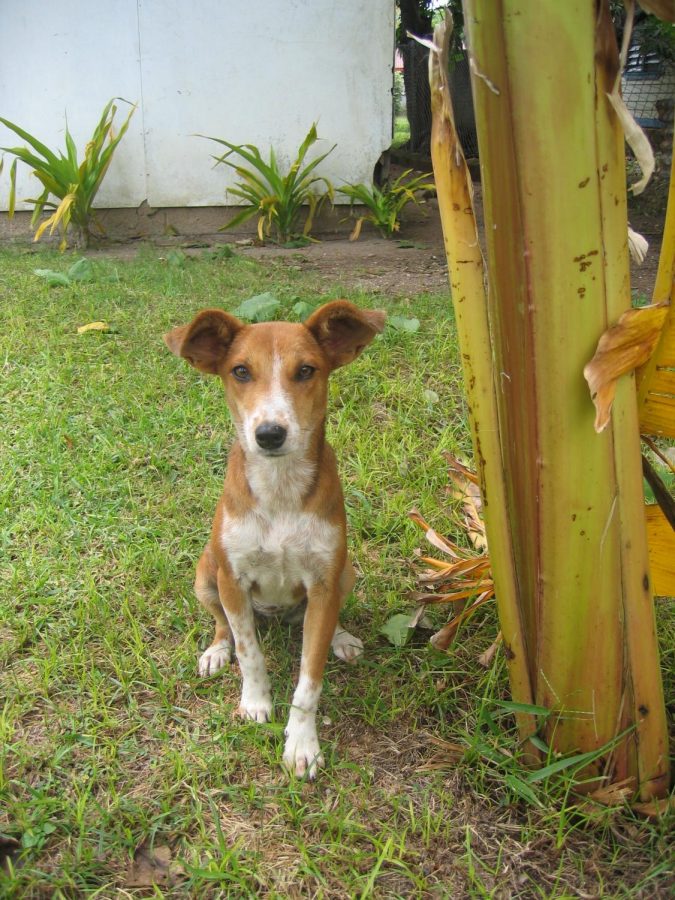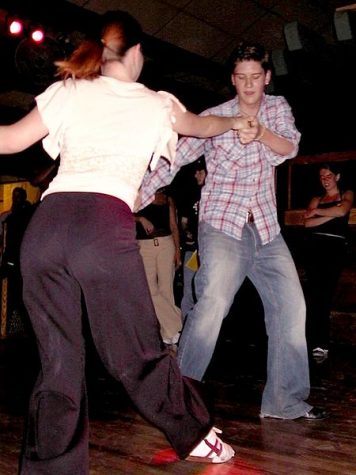Educator’s Corner: Tall tales with tails on Tonga
This is Mickey, a Tonga dog that made friends with ESL teacher Soraya Bilbao while she served in the Peace Corps. Bilbao notes, “Mickey was a very sweet dog. I wish I could have brought her back to the U.S. with me.”
February 23, 2019
Editor’s note: ESL teacher Soraya Bilbao wrote this piece while she was serving in the Peace Corps in Tonga. A version was previously published in Hersam Acorn Newspapers. Educator’s Corner is guest column space for faculty and staff. Email [email protected] if interested.
Man’s best friend. Ask anyone in the United States and they’ll tell you that this statement refers to none other than one’s own loyal family member, the dog. Lassie. Benji. Old Yeller. Regardless of their name, these furry little creatures elicit warm fuzzy feelings and have won a special place in our hearts and homes. So much so that if a dog were to scamper up to us at some park, we would instinctively bend down to pet it, all the while proclaiming in that high-pitched voice we tend to reserve for anyone under two years of age, “Come here, boy! Come on! Oh, you’re such a good little doggy! Oh, yes you are!”
Ah, the good ol’ days.
There is a scene in the movie The Wizard of Oz where Dorothy looks at her cute little pooch and exclaims, “Toto, I’ve a feeling we’re not in Kansas anymore,” and I couldn’t agree with her more. Wake up and smell the Frangipani, a deliciously sweet smelling flower common in the South Pacific. This is Tonga, where dogs are anything but cute.

As part of Peace Corps pre-service training, before one is sworn-in as a volunteer, trainees receive language, culture, health, and safety training. One of the topics that my training group (Group 68) and I were scheduled to discuss was dogs. The fact that we were scheduled to talk about them didn’t faze me since I’m always up for learning about animals. What surprised me was the fact that it was slotted as part of safety training. Unfortunately, as I would later find out, rightly so.
From a purely observational standpoint, there doesn’t seem to be any sort of leash law or registration requirements for owning dogs in Tonga. If there does happen to be one on the books, then based on the number of people I know who have had the misfortune of having been involved in some sort of dog attack, enforcement has some catching up to do.
During my first two years of service, volunteers reported numerous attacks to the Peace Corps office. The informal count of near misses, which are usually recounted as larger-than-life tales, is exponentially greater.
Forget pigs-in-a-blanket, a popular appetizer in the United States consisting of small hot dogs wrapped in baked pastry shells; volunteers-on-wheels (bicycles) seem to be the preferred hors d’oeuvre among these mutts.
Back at training, once the dire statistics and the realities of living among packs of free-range dogs were presented. “No, if a dog runs up to you, you may not bend down to pet it,” we were instructed in the ways of some high-tech, self-defense techniques. These involved the acquisition of some good-sized rocks, usually found on the side of any road, and if you were lucky, the possession of a good throwing arm. Thin long whipping branches would do just as well, but this would undoubtedly require invading Cujo’s personal space, something which I hoped to avoid during my time in Tonga.
If neither of these accessories were at hand, then volunteers were encouraged to tap into their creative right brains and engage in some impromptu pantomime. The idea here was to go through the motion as if we were bending down to pick up some hefty rock and then go through the motion as if we were about to throw it at the already agitated canine.
This technique, other volunteers assured us, worked pretty well in deterring dogs. However, it in no way guaranteed that they would follow suit and just go through the motions as if they were gnawing at one of our extremities without actually doing so. Therefore, at a minimum, if bought us a few seconds to… eh… well… just bought us a few seconds, I guess.
At first, many of us were taken aback to hear of such extreme measures against dogs. Having been a happy dog owner and a fan of Animal Cops, I couldn’t imagine participating in such exercises. However, after several instances of doggies stalking and chasing after me — I’d like to believe due to some honest inadvertent mistake in which I was confused for some squeaky chew toy — the question is no longer, “To throw or not to throw?” but rather, “Aren’t there bigger rocks on this road?!“

The kingdom of Tonga.
Necessity is the mother of invention and I’ve devised a deterrent technique of my very own (patent pending). If a dog charges at me, I no longer waste precious seconds looking for sticks and stones. These may break some doggy bones, but the handful of twigs and pebbles that usually result from my spur-of-the-moment road explorations won’t hurt them.
Instead, I plan ahead and carry my own arsenal bag fully loaded with whatever food I packed for lunch that morning. This way, when a dog gets a little too close for comfort, I simply reach in and throw a good-sized chunk of my peanut butter and jelly sandwich in the hopes of redirecting its attention, giving me an opportunity to speed-walk my way out of a compromising situation.
Disclaimer: If you are inclined to employ this technique, be sure to pack your lunch bag with things that dogs might actually want to eat. I found that pieces of stale bread just bounce off their heads and fall unnoticed to the ground. Oh, and you may get a little hungry at lunch, so bring extra Pa’anga (Tonga’s currency).
I’ve spent many an hour in deep thought and contemplation, which has resulted in the formulation of a ground-breaking hypothesis. Simply stated, it asserts that dogs are nocturnal creatures.
Based on my ongoing personal encounters with Tongan dogs, it seems that the darn things don’t sleep at night. Instead, like street gangs, they congregate and loiter around the street corners of dark, always dark I’ve noticed, pathways and wait to ambush some poor unsuspecting soul who realized too late that she was out of milk and thought it would be a swell idea to take a short walk to the falekoloa –– the Tongan word for a “goods store,” just two blocks over.
As if this wasn’t enough, a Peace Corps volunteer, who was nearing the end of his two-year service, shared with me that from his own personal experience: the dogs that bite are the ones that don’t bark or make a sound. Great, just great. Dealing with dog gangs in dark streets is one thing, but ninja dogs? Come on people, throw me a bone!
His logic actually makes perfect sense. A barking dog is too busy warning you that you are trespassing on his territory, which usually involves the one stretch of public road you need to get through to reach your destination, whereas a dog on stealth mode may already have your sandal in its mouth, therefore, couldn’t possibly be expected to bark with its mouth full. That would be like so impolite.
Life has taught me to go with the flow and appreciate what I have. Rest assured that I”ll be most appreciative when I have a couple of large rocks stored in my backpack for my walk back home this afternoon.


































